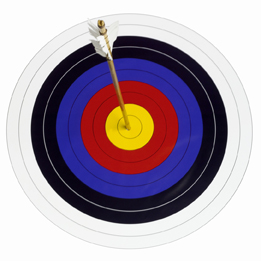In Try This 2 you derived the equation for the unit circle, x2 + y2 = 1. Any point that is on the unit circle will satisfy this equation.
Compare what you did in Try This 2 with the derivation of the equation for the unit circle on page 182 of the textbook. Note any differences and similarities you see.
The equation x2 + y2 = 1 only describes a circle that has a radius of 1; but you have seen that circles can have different radii, such as the circles in an archery target or the water ripples you saw in Focus. How can you write equations for circles with different radii?

Stockbyte/Thinkstock
Read “Example 1” on page 182 of the textbook. Notice how the Pythagorean theorem is used to write the equation for a circle with a radius of 2.
Watch Equation of a Unit Circle to see how the Pythagorean theorem can be used to write the equation of a circle with centre (0, 0) at the origin and any radius length represented by r.

Complete question 1.b. on page 186 of the textbook. Answer